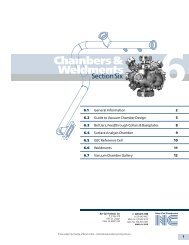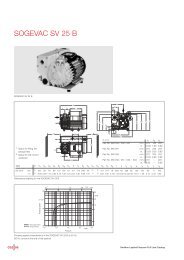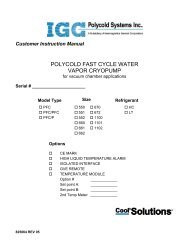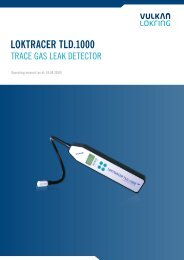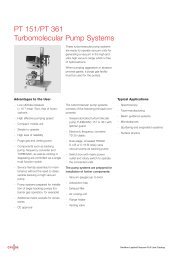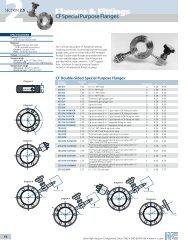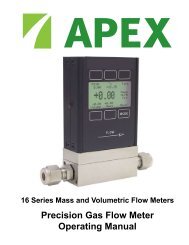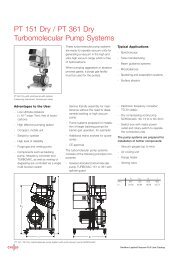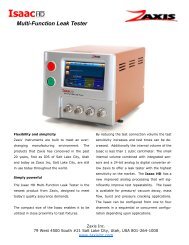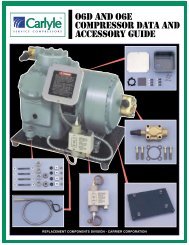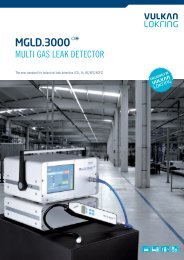B2 - Schoonover, Inc.
B2 - Schoonover, Inc.
B2 - Schoonover, Inc.
You also want an ePaper? Increase the reach of your titles
YUMPU automatically turns print PDFs into web optimized ePapers that Google loves.
Leak Detectors<br />
Operating Principles of the INFICON Helium Leak Detectors<br />
of a cold trap permits the low operating pressures for the mass<br />
spectrometer to be reached (below 10 -4 mbar) despite the directly<br />
connected (and possibly contaminated) test object.<br />
The helium which now enters the forevacuum can still be detected, as it is<br />
able to flow against the pumping direction of the turbomolecular pump into<br />
the mass spectrometer. This is due to the high particle velocity of the<br />
helium. The sensitivity of this counterflow arrangement is equal to that of<br />
the main flow principle, provided the right combination of volume flow rate<br />
of the backing pump and helium compression of the turbomolecular<br />
pump is used.<br />
The advantages of the counterflow method are:<br />
Ð No liquid nitrogen is required<br />
Ð High permissible inlet pressures (i.e. pressure within the test object)<br />
This makes the counterflow method especially suitable for mobile leak<br />
detection on systems. For leak detection on larger components where a<br />
short response time is essential (i.e. high volume flow rate) an additional<br />
turbomolecular pump stage is required at the inlet of the leak detector.<br />
The INFICON leak detector ULTRATEST UL 500 is the only instrument to<br />
offer this optimized counterflow method.<br />
Main flow method<br />
The advantages of the main flow method are:<br />
Ð Highest sensitivity, i.e. low detection limit<br />
Ð Short response time due to a high volume flow rate at the inlet.<br />
The main flow method is thus especially suitable for stationary leak<br />
detection on components. Leak detection on systems having their own<br />
pump sets and at higher pressures requires the use of an external throttling<br />
valve, i.e. a partial flow with subsequently reduced sensitivity is utilized.<br />
Counterflow Method<br />
With this method the test object is not connected to the high vacuum.<br />
Instead it is connected to the forevacuum (between turbomolecular pump<br />
and backing pump), so that the entire gas flow (especially water vapor)<br />
does not contribute to the pressure increase in the mass spectrometer.<br />
Thus a cold trap is no longer required!<br />
Partial Flow Method<br />
In order to expand the measurement range in the direction of higher leak<br />
rates and for operation at higher inlet pressures, helium leak detectors<br />
incorporate a partial flow or a gross leak system. This consists basically of<br />
a throttle and a rotary vane pump. At pressures above the normal inlet<br />
pressure (main flow: above 10 -2 mbar, counterflow: above 10 -1 mbar) or in<br />
the case of high helium leak rates, the inlet valve is closed and the main<br />
flow is allowed to enter the partial flow pump, whereas only a small part<br />
enters the leak detector via the partial flow throttle. Thus the total pressure<br />
and the helium pressure are dropped to values suitable for operation of the<br />
leak detector.<br />
Main flow or<br />
counterflow<br />
leak detector<br />
Partial flow method<br />
To obtain correct leak rate readings in the partial flow mode, the partial flow<br />
ratio, i.e. the ratio between the actually measured gas flow and the total<br />
gas flow must be known and stable.<br />
Counterflow method<br />
In all INFICON leak detectors this is achieved by a partial flow throttle<br />
made of ruby with a precisely machined hole. This ensures that the<br />
quantitatively determined leak rates are always correct without calibration,<br />
even for gross leaks.<br />
B5.8




